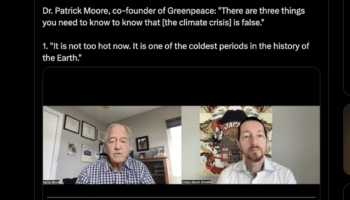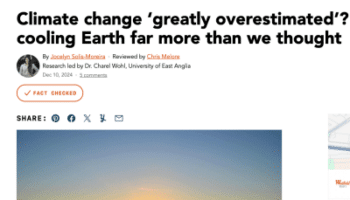- Climate
Link between CO2 and Earth’s temperature is well-established, despite claims on Fox News
Key takeaway
The link between global warming and atmospheric CO2 levels is well-established; in fact, increases in CO2 have warmed the planet multiple times over the last million or so years. Science shows unambiguously that current climate change is caused by human-emitted greenhouse gases. Based on this knowledge, scientists are confident that any grand solar minimum will not result in a cooling trend, as changes in total solar irradiance are not projected to be enough to offset human-caused warming.
Reviewed content

Verdict:
Claim:
Scientists have found no consistent correlation between CO2 and temperature; scientists do not know whether earth will warm or cool in future
Verdict detail
Inaccurate:Past climate data show a correlation between CO2 concentration and global temperature, and physics shows CO2 is a greenhouse gas that strongly influences the temperature of the Earth’s surface.
Unsupported: Research has shown that solar activity variations are not enough to offset human-caused warming.
Full Claim
Scientists have found “No consistent correlation between carbon dioxide and earth’s temperature”; “It’s all based on models that don’t work”; “we don’t even know whether it’s going to warm or cool in the future”; various scientists show “we’re headed into a grand solar minimum around 2060, and that we’ll see gradual cooling over the next few decades”
In an interview with Fox News on 12 October, International Climate Science Coalition Executive Director Tom Harris made multiple misleading and inaccurate claims about climate change. The International Climate Science Coalition disputes the scientific consensus that human activities are causing the planet to warm.
Harris, who has a background in mechanical engineering, quoted a university professor who Harris claimed found that there was “no consistent correlation between carbon dioxide and earth’s temperature.”
“At times, CO2 was 1300% of today, and we were stuck in very cold conditions,” Harris said.
On the contrary, paleoclimate data from the last 800,000-plus years show that the link between temperature and CO2 is well-established. Scientists discovered CO2’s role in warming the planet in the mid-19th century, noted James Renwick, Professor, Victoria University of Wellington, in a previous review of a similar claim.
“Through the past 2.6 million years, the period of recent ice ages, carbon dioxide has gone up and down in step with temperature, bottoming out at around 180 parts per million in the depths of a “glacial maximum” and peaking at around 280 parts per million in the warmer interglacial periods, he said in the review. “Going back further, CO2 levels were certainly higher than present, but so were temperatures.”
Figure 1 shows that CO2 concentrations have oscillated in conjunction with Earth’s temperature for the last 800,000 years.
Figure 1 – Graphs show CO2 and temperature oscillations over the last 800,000 years for the global average and Antarctica. Credit: Ben Henley and Nerilie Abram, The Conversation.
The Ordovician Period, which began 485.4 million years ago, saw CO2 levels that were 8 times higher than today.[1] Based on paleoclimate data, the later part of this period experienced glaciation – though that coolness does not invalidate the link between CO2 and warming, and was likely aided by a less-bright sun; the placement of the continents, which at that time were bunched together; and a drawdown of CO2.
“There were periods of times when CO2 was very high, likely as high as 1500-2000 ppm,” Katrin Meissner, Professor, University of New South Wales, said in a previous review. “The ecosystems and biogeochemistry were adapted to these conditions, and they looked very different from today. There were no humans, many of the mammals around us did not exist. Not to mention that the sun’s energy output was slightly smaller during that time.”
The last time the planet experienced CO2 levels this high was more than 3 million years ago. During that time – called the Mid-Pliocene Warm Period – the planet’s surface temperature was 4.5–7.2 degrees Fahrenheit (2.5–4 degrees Celsius) warmer than during the pre-industrial era, according to NOAA Climate.gov.
Scientists are confident in the finding that increased CO2 concentrations are causing Earth’s temperature to rise.[2] As CO2 and other greenhouse gases are emitted into the atmosphere, they trap more of the sun’s energy, leading to warming. “It is unequivocal that human influence has warmed the atmosphere, ocean and land,” the IPCC notes in its Sixth Assessment Report.[3]
While remaining in the atmosphere, CO2 prevents heat from escaping and consequently warms the surface of Earth – a concept that is popularly known as the greenhouse effect. This theory predicts that the increase in temperature will be proportional to the logarithm of the concentration of CO2, with a time-lag of about 20 years. Figure 2 shows that this is precisely what the data shows, hence providing a strong validation of the theory, in addition to other lines of evidence. Meanwhile, Figure 3 shows how global average annual temperature has increased in tandem with CO2 concentrations since 1880.
Figure 2 – Global temperature plotted against atmospheric CO2 concentration. Note the logarithmic scale of the x-axis is due to the nature of the relationship between greenhouse gases and temperature.[7] Source: Berkeley Earth via a previous Climate Feedback review.
Figure 3 – Global annual average temperature (as measured over both land and oceans) has increased by more than 1.5°F (0.8°C) since 1880 (through 2012). Red bars show temperatures above the long-term average, and blue bars indicate temperatures below the long-term average. The black line shows atmospheric carbon dioxide (CO2) concentration in parts per million (ppm). Credit: globalchange.gov.
Harris also claimed that climate science is based on “models that don’t work.” Climate science is based both on observations – including temperature and other weather records – and models. Climate models simulate the earth’s climate system, and use mathematical equations to project how the planet may respond under different scenarios (i.e. low greenhouse gas emissions, business as usual emissions, etc.) as well as to recreate the climate at different times in the planet’s past. These models are complex: According to the National Centre for Atmospheric Science, “there are so many mathematical equations involved that a typical climate model includes enough code to fill 18,000 pages of printed text.”
These models have proved to be accurate – though imperfect – tools. In fact, a 2019 study found that climate models have been skillful in projecting changes in the Earth’s temperature.[4] “Climate models published over the past five decades were generally quite accurate in predicting global warming in the years after publication, particularly when accounting for differences between modeled and actual changes in atmospheric CO2 and other climate drivers,” the study notes.[4]
Scientists test models through a process called hind-casting, during which scientists run the model in the recent past and compare what the model shows to the observed climate and weather during that time period. This way, scientists are able to see how closely the model’s projections line up with actual weather and climate results – and, if needed, adjust the model accordingly.
“Climate models are imperfect representations of nature that represent just one tool scientists use to understand how and why Earth’s climate varies,” Timothy Myers, Postdoctoral Researcher at Lawrence Livermore National Laboratory, said in a previous review. “Climate models are good at simulating some physical processes and deficient in their simulation of other processes. Simply because the climate is complex does not mean we cannot reasonably model or understand it.”
Harris also claimed that experts aren’t sure whether the globe will warm or cool in the future, and that “various people that study the sun” say that Earth is headed towards a grand solar minimum, which will result in gradual cooling.
Research, however, disputes this claim of future cooling. A 2016 study found that human emissions would delay the next ice age by about 50,000 years.[5] And a 2013 study found that a grand solar minimum would slow down global warming – but that the rate of warming would go back up once total solar irradiance started to rise again.[7]
“Therefore, results here indicate that such a grand solar minimum would slow down and somewhat delay, but not stop, human-caused global warming,” the study concludes.[6]
Figure 4 – Rise of global temperature for two different emission scenarios (A1B, red, and A2, magenta). The dashed lines show the slightly reduced warming in case a Maunder-like solar minimum should occur during the 21st century. The blue line represents global temperature data. Source: Potsdam Institute for Climate Impact Research; taken from a previous Climate Feedback Review.
NASA agrees that if a grand solar minimum were to occur in the next few decades, it would not be enough to offset human-caused warming.
“The warming caused by the greenhouse gas emissions from the human burning of fossil fuels is six times greater than the possible decades-long cooling from a prolonged Grand Solar Minimum,” NASA writes in a 2020 article. “Even if a Grand Solar Minimum were to last a century, global temperatures would continue to warm. The reason for this is because more factors than just variations in the Sun’s output change global temperatures on Earth, the most dominant of those today is the warming coming from human-induced greenhouse gas emissions.”
References
- [1] Pancost et al. (2013) Reconstructing Late Ordovician carbon cycle variations. Geochimica et Cosmochimica Acta.
- [2] Stips et al. (2016) On the causal structure between CO2 and global temperature. Scientific Reports.
- [3] IPCC (2021) Climate Change 2021: The Physical Science Basis. Contribution of Working Group I to the Sixth Assessment Report of the Intergovernmental Panel on Climate Change.
- [4] Hausfather et al. (2019) Evaluating the Performance of Past Climate Model Projections. Geophysical Research Letters.
- [5] Ganopolski et al (2016) Critical insolation–CO2 relation for diagnosing past and future glacial inception. Nature.
- [6] Meehl et al. (2013) Could a future “Grand Solar Minimum” like the Maunder Minimum stop global warming? Geophysical Research Letters.
- [7] Huang et al. (2004). Why logarithmic? A note on the dependence of radiative forcing on gas concentration. Journal of Geophysical Research: Atmospheres.







